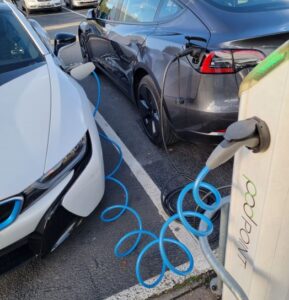
Like Gas Stations, EV Chargers Need Amenities and Other Sources of Revenue to Succeed
New report finds that the presence of amenities near public EV chargers will increase charging station use, contributing revenue, which could help to offset EV infrastructure costs
California EV drivers are willing to pay more for more accessible charging with zero wait
SACRAMENTO, Calif.–(BUSINESS WIRE)–Just like gas stations, EV charging infrastructure requires additional sources of revenue to be profitable. Whether it’s a gas station or an EV charging station, co-located services and amenities are needed to improve return on investment, according to a new report and EV driver survey released today by Next 10 and authored by the Institute for Transportation Studies at UC Davis.
A survey from the same report finds that California EV drivers, whether or not they can charge at home, are willing to pay a premium for more accessible fast public charging, especially if one can charge near other services with little to no wait. Based on these insights, the report, Analyzing the Business Case & Consumer Preferences for Fast Chargers in California, includes recommendations on where to place EV charging stations to maximize use and revenue.
“We already know that the next generation of EV owners want more public chargers,” said Noel Perry, founder of the non-partisan, non-profit Next 10. “This report shows that building chargers where people are and where they want to be, especially for longer trips, is what’s best for both California drivers and charging station investors.”
This analysis shows public chargers are frequented more when located within 500 meters of both dining services (with an average increase of 2.7 times more charging events per month per nearby restaurant) and grocery stores (with an average increase of 5.2 times more charging events per month per nearby grocery store). Chargers could therefore bring more customers to businesses (improving business revenue) or fast chargers could be located with amenities co-owned by charging providers to provide a viable alternative revenue source and help break even on EV charger costs.
The survey data reinforces the findings on charging behavior:
- Rest stops (74%), malls (71%), parking garages (65%), and restaurants (59%) were the most commonly selected public charging locations, indicating that California EV drivers also prefer charging at destinations they frequently travel to or where they have opportunities to do other activities while they charge.
- California EV drivers are 37% more likely to choose a charger with additional amenities (for example, restrooms and convenience stores).
- Drivers are also more likely to choose chargers that are closer to travel routes, have shorter wait times, and have faster chargers.
“Our research shows us what electric vehicle drivers want: fueling infrastructure located with additional amenities that can also help stations become profitable,” said Dr. Scott Hardman, Associate Research Faculty for the Electric Vehicle Research Center at UC Davis. “Whether it’s a gas station or an EV charging station, co-located services and amenities are needed to improve ROI and are what people want.”
The survey found that EV drivers are willing to pay a premium for chargers with no wait time, and access to other services along with charging is especially attractive for California EV drivers. This added cost for convenience is offset by the savings of fueling with electricity instead of gasoline.
- California EV drivers would be willing to pay almost a dollar more per hundred miles of charge if no wait time is required.
- The cost to go 100 miles in an EV falls between $8 to $13 while the average gasoline car costs approximately $18.50 to go the same distance.
- Wait times for chargers deter drivers. If a charger requires a wait, the odds that a driver will choose that charging station decrease by 13% (0.87).
- Every minute of extra wait time reduces the willingness to use a charger by 6%.
- A California EV driver is 37% more likely to choose a charging station within close proximity to other services (like a restaurant or playground) than one located in isolation.
- Making fast chargers available at frequently visited public locations like grocery stores, green spaces and restaurants is likely to address the concerns of EV drivers while adding potential revenue to adjacent businesses.
“EV drivers are telling us that they want chargers co-located with amenities like cafes and restaurants, and they are willing to pay more to charge at locations with the amenities,” said Alan Jenn, Assistant Professor at the Electric Vehicle group of the Institute of Transportation Studies at UC Davis. “This symbiotic relationship between businesses and EV chargers may benefit both EV chargers and local businesses.”
Subsidies allow for faster recouping of costs regardless of whether services and amenities are co-located to drive additional revenue. Subsidies are important for creating greater access where co-locating with services isn’t possible or not profitable. Without subsidies, it would take more than 10 years to break even on charging infrastructure investments based on average use. Other options for reducing the payback period include leveraging symbiotic business relationships between convenience stores or restaurants and EV chargers, changes in the charging model, increases in electricity prices, or reductions in charging installation costs beyond subsidies.
 Historically, new technology adoption requires subsidies to get infrastructure where it’s needed most. For example, this year’s federal budget set aside more than $40 billion for states to build broadband internet infrastructure. The Bipartisan Infrastructure Law invested $2.5 billion in the Charging and Fueling Infrastructure (CFI) Discretionary Grant Program with a 10% set-aside from the National Electric Vehicle Infrastructure (NEVI) Formula Program. Globally, fossil fuel subsidies reached a record high of $7 trillion in 2022.
Historically, new technology adoption requires subsidies to get infrastructure where it’s needed most. For example, this year’s federal budget set aside more than $40 billion for states to build broadband internet infrastructure. The Bipartisan Infrastructure Law invested $2.5 billion in the Charging and Fueling Infrastructure (CFI) Discretionary Grant Program with a 10% set-aside from the National Electric Vehicle Infrastructure (NEVI) Formula Program. Globally, fossil fuel subsidies reached a record high of $7 trillion in 2022.
“California is leading the nation in EV charging infrastructure investment,” continued Perry. “We hope our research will help fill a gap in understanding so we can continue to be strategic about where and how EV charging gets built to best serve drivers and our communities. For now, subsidies remain critical to meeting that goal.”
While the demand for public charging is strong, the report survey reiterates the importance of home charging, finding that, without access to home charging, 35% of EV owners would replace their EV with a traditional gas car, while 38% and 41% would replace their EV with a plug-in EV or a hybrid, respectively.
- 84% of California EV drivers are worried about the lack of charging options outside their homes.
- 70% of California EV drivers surveyed reported having used public charging stations.
- 66% of California EV drivers said they were concerned about the cost of publicly available chargers.
- 84% of California EV drivers are worried that public chargers would take them too far out of their way.
“EV sales continue to rise so we must do what we can to speed the build-out of charging infrastructure to meet growing demand,” concluded Perry. “We can’t lose sight of where the market is headed and meet these challenges head-on.”
Many California utility providers and air districts offer rebates for home charging stations. Governor Newsom’s Executive Order requires the installation of 250,000 publicly available EV chargers by 2025. For every 1,000 EVs in the United States, there are approximately 20 publicly available fast chargers — half of those are in California. Overall, the report recommends that California continue to support charging access at home and in the community while balancing subsidies with strategies for improving the profitability of charging stations. Key recommendations of the report include:
- Increase the availability of public chargers at places where Californians do or want to visit, while upping the efficiency with DC fast chargers.
- Increase public support for home charger installation while using consumer preferences as a guide post.
- Balance public subsidies with strategies for encouraging the profitability of EV charging stations independent of outside intervention.
Contacts
MEDIA CONTACT: Christina Heartquist
408-661-2666, christina@sunstonestrategies.org


